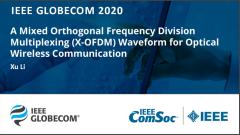Chlorophyll concentration-based CSK constellation point optimization for Underwater SLIPT using Time Splitting receiver
Simultaneous lightwave information and power transfer (SLIPT) plays an important role in constructing a flexible underwater network system to achieve both underwater visible light communication (UVLC) and underwater power transfer. In this paper, color shift keying (CSK) is considered as a modulation method of underwater SLIPT (USLIPT). The CSK is a VLC intensity modulation scheme, which is outlined in IEEE 802.15.7, that transmits data imperceptibly through the variation of the color emitted by red, green, and blue laser diodes (RGB LDs). In this paper, optimized CSK (OCSK) constellation is presented for USLIPT, which is optimally adjusted constellation by interior point algorithm to avoid the effect of underwater spectral attenuation and achieve the stable power transfer. By using the constellations, the USLIPT can achieve a variability rate of total received power of 0 %, with taking into account underwater optical wireless channels and channel crosstalk by the characteristics of RGB LDs, RGB bandpass filters, and solar panels. The Euclidean minimum distance of both the conventional IEEE CSK and proposed OCSK constellation shows that the OCSK constellation achieves the larger minimum distance compared with that of conventional IEEE CSK constellation. Also, harvested energy of the OCSK is bigger than that of On-Off Keying modulation in Time Splitting method.
 Cart
Cart Create Account
Create Account Sign In
Sign In





